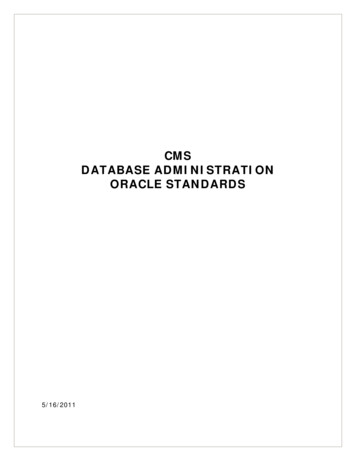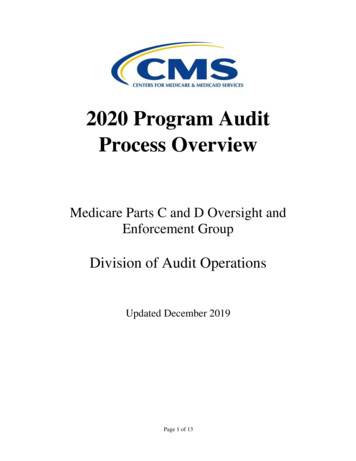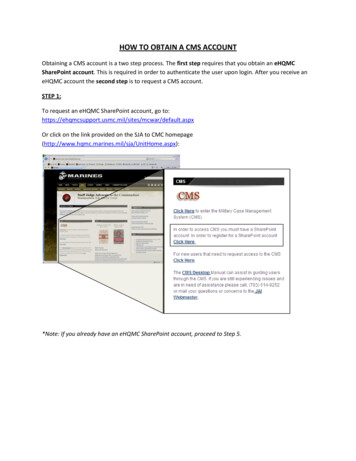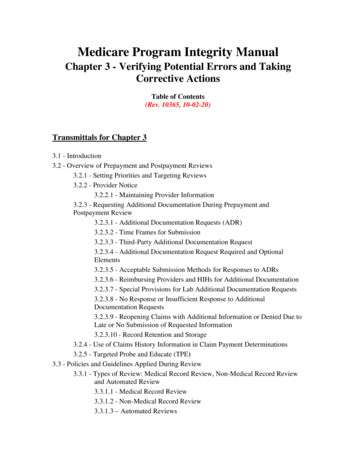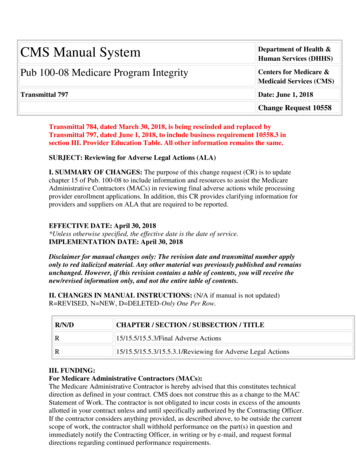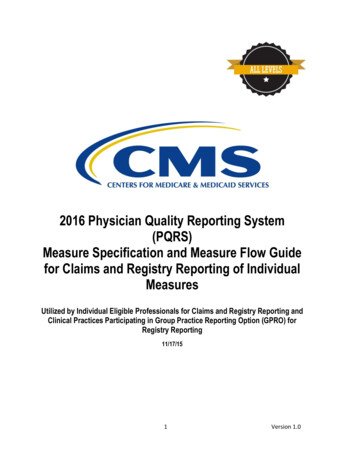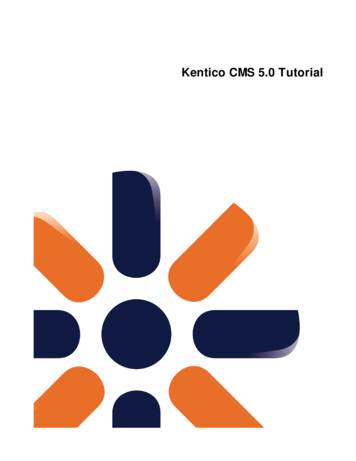
Transcription
Kentico CMS Tutorial 4.1
2Kentico CMS Tutorial 4.1Table of ContentsPart I Introduction51 Kentico CMS .Overview5Part II Installation71 Prerequisites. 72 Setup installation. 83 Web application.installation94 Database setup.and Corporate Site14Part III Managing content201 User interface.overview202 Editing home.page content233 Creating a new.page244 Inserting an .image275 Creating a link. 296 Creating a news.item32Part IV Site Development Overview361 Site Development.Overview36Part V Creating pages using the portal engine411 Page templates. 412 Overview of.web parts433 Modifying the.home page structure454 Creating a new.page template495 Re-using the.page template526 Visual inheritance. 547 Configuring .visual inheritance568 Web part containers. 609 Adding custom.code to your web site62Part VI Developing web parts651 Web part development.overview652 Creating a simple.web part683 Web part modifications. 72Part VII Managing styles and design74 2009 Kentico software
Contents31 CSS styles . 742 App themes. 763 Menu design. 7781Part VIII Creating a new site using the portal engine1 Overview. 812 Creating a new.web site using a wizard823 Creating a CSS.stylesheet924 Master page. 945 Main menu. 1006 Page placeholder. 1017 Home page. 1028 Container for.home page text1059 News page. 10610 Services page. 11011 Products page. 113Overview .New document.typeTransformations.Page template.11311311912212 Search page. 12613 Secured section.for partners127Part IX Further steps1321 Further steps. 132 2009 Kentico software3
PartI
Introduction1Introduction1.1Kentico CMS Overview5Kentico CMS for ASP.NET helps you create powerful dynamic web sites with minimum effort. Thisdocument will guide you through the most important features of the system step-by-step, so that youcan start creating your own web sites.This document was written for evaluators and new users. It's intended for developers who create theweb sites. It's not intended for end-users without programming knowledge.If you need a more detailed documentation of some features, please see one of the followingdocuments:····Developer's GuideWeb parts and Controls ReferenceAPI ReferenceDatabase ReferenceKentico CMS SupportYou get free technical support during your evaluation period. If you need any help,please visit http://www.kentico.com/Support.aspx 2009 Kentico software
PartII
Installation2Installation2.1Prerequisites7Before you start the installation, please make sure you have the following software installed:· Operating system: Microsoft Windows 2000, XP, or Vista, Microsoft Windows Server 2000, 2003or 2008· Web server: Internet Information Services (IIS) or Visual Studio 2005 or 2008 or Visual WebDeveloper 2005 or 2008.· Database server: Microsoft SQL Server 2000, Microsoft SQL Server 2005 or Microsoft SQL Server2005 Express Edition, Microsoft SQL Server 2008. The database server can be installed on aremote server.· Development tools: Visual Studio 2005 or 2008 or Visual Web Developer 2005 or 2008.Required experienceAlthough Kentico CMS allows you to create dynamic web sites without programming, you may need tocreate custom web parts or to add custom code when developing a more complex web site. Youshould be able to create a simple application in ASP.NET 2.0 using Visual Studio 2005 and have someexperience with relational databases and SQL, so that you can leverage the flexibility of Kentico CMS. 2009 Kentico software
82.2Kentico CMS Tutorial 4.1Setup installationTroubleshooting installation issuesIf you encounter any problems during the installation, please see Kentico CMSDeveloper's Guide - Installation and deployment - Troubleshootinginstallation issues or contact our support at http://www.kentico.com/Support.aspxRun KenticoCMS.exe and follow the installation wizard:Read and accept the license agreement and click Next. Choose the installation location of the binaryfiles and documentation on your disk. After the setup completes the installation, choose to LaunchKentico CMS Web Installer and click Finish. 2009 Kentico software
Installation2.39Web application installationNow you should see the Kentico CMS Web Installer. If you cannot see it, you can always run it fromStart menu - All Programs - Kentico CMS 3.x - Kentico CMS Web Installer.First, you need to choose the version of .NET Framework and Visual Studio that you wish to use.Click Next.Choose to use either IIS server or Visual Studio 2005 built-in web server (if you do not have IISinstalled). Click Next. 2009 Kentico software
10Kentico CMS Tutorial 4.1IIS installationIf you choose the IIS server, you can choose the web site where the virtual directory will be createdand the folder on your local disk where project files will be deployed. The installer will create a newvirtual directory on your server and configure it for ASP.NET. Click Next.Please note: if you're installing Kentico CMS into the root of your web site (such as http://www.domain.com) and do not wish to create a virtual directory (such as http://www.domain.com/cms),please check the This is an installation to the root (do not create virtual directory) check-box. 2009 Kentico software
Installation11VS2005 installationIf you chose to use the built-in server in VS2005, you only need to specify the local disk where theproject files will be deployed. Click Finish. 2009 Kentico software
12Kentico CMS Tutorial 4.1Type of installationNo matter if you chose the IIS or VS installation, the next step after specifying the target folder is theselection of installation type. The following two types of installation are available:· Full installation - this is the recommended option for the purposes of this tutorial; in this type ofinstallation, all components of the CMS will be installed· Custom installation - in this type of installation, one extra step will be displayed, letting you choosewhich components you want to include in the installationClick Next to start the installation process.After the setup copies all files, you will see the link for opening the web application in browser or theweb project in Visual Studio. Click the link. 2009 Kentico software
Installation13Opening the web site in VS2005If you chose VS2005 installation, the project is opened in VS2005:Choose Debug - Start without debugging from the main menu. The site will be displayed in newbrowser window using the built-in web server.When you cannot open the web site in Visual Studio 2005If the link for opening the project in Visual Studio doesn't work, you may need to startVisual Studio manually and choose File - Open - Web Site. and locate the projectfolder on your disk manually. 2009 Kentico software
142.4Kentico CMS Tutorial 4.1Database setup and Corporate SiteNow you should see the Database setup in your web browser.Choose the SQL Server name or IP address. If you're using SQL Server 2005 Express Edition, thedefault server name is .\SQLExpress or (local)\SQLExpress.You can use either SQL Server authentication (recommended) or integrated Windows authentication.· In case you use SQL Server account, you need to enter the user name (such as sa) and password.· In case you use Windows authentication, you need to ensure that the ASP.NET account of thename displayed in the brackets has an appropriate login name in your SQL Server.The account must be granted with permissions for creating new databases or for creating databaseobjects in an existing database.Click Next. 2009 Kentico software
Installation15Choose to use an existing database or to create a new one. Click Next. If no error occurs, you shouldsee the last step: 2009 Kentico software
16Kentico CMS Tutorial 4.1You can choose from the following options:· Choose a starter site:· Corporate Site (portal engine) - this option installs the sample corporate site - it isrecommended for most users, especially for evaluators.· Corporate Site (ASPX templates) - this option is recommended only for experienced ASP.NETdevelopers who want to use ASPX page templates instead of portal templates.· E-commerce site - this sample site can be used as a starting point for creating your own e-shopand shows the possibilities of Kentico CMS's E-commerce module.· Personal site - this is a web template suitable for a simple personal site.· Community site - complex web template suitable for community webs, showing Kentico CMS'ssocial networking features in practice.· Blank site - this is a blank site without any content; you will use it to create a new site fromscratch.· Blank site ASPX - the same as above, but for ASPX poage templates.· Continue to the New site wizard - this option is recommended if you're starting a new site fromscratch.· Import an existing Kentico CMS web site - use this option is you already created a web site withKentico CMS and need to import it into the new installation (e.g. on the production server).For the purpose of this guide, please choose to create sample Corporate Site and click Next. Youwill see the confirmation and a link to your new web site: 2009 Kentico software
InstallationClick the link and you will be redirected to the title page of the sample Corporate Site: 2009 Kentico software17
18Kentico CMS Tutorial 4.1Sample web siteThe Corporate Site web site is only an example of a web site you can create withKentico CMS. You have full control over the site structure, design, page layout andfunctionality as you will see in the following chapters. 2009 Kentico software
PartIII
20Kentico CMS Tutorial 4.13Managing content3.1User interface overviewClick the Sign in to CMS Desk link at the top of the web site or go tohttp:// domain / virtualdirectory /cmsdesk. You will be asked for user name and password.Default user name and passwordThe default user name is administrator with blank password.It's highly recommended that you change the password before you publish the website on the live server.Once you sign in, you will see a splash screen, giving you some basic information. Click the Continuebutton, you will be redirected to the following page: 2009 Kentico software
Managing content21The user interface consists of the following main sections:· Main menu with Content, My Desk, Tools and Administration sections.· Document actions toolbar with buttons for creating new documents, deleting, copying, moving andsorting documents.· View mode selection that allows you to choose between editing, preview, live view and list view.· Content tree that represents the site map of the web site and allows you to organize the structure ofdocuments and choose document that appears on the right side of the screen.· Page editing mode - you can choose to edit page content, design the page template, edit thedocument fields, product properties or document properties.· Editing/viewing space - here you can view/edit the document selected in the content tree in themode selected in the view mode toolbar and in the page editing mode toolbar.CMS Desk and Site ManagerCMS Desk allows content editors to edit content of a single web sites. Developers and siteadministrators who need to manage settings, code and configuration of all web sites, can use also theSite Manager interface. The Site Manager interface is accessible either through the webproject /CMSSiteManager URL or by clicking the Switch to Site Manager link at the top of theCMS Desk user interface. The following figure shows how the database, Site Manager, CMS Desk andweb sites are related: 2009 Kentico software
22Kentico CMS Tutorial 4.1 2009 Kentico software
Managing content3.223Editing home page contentNow we will modify the home page content. Click Home in the content tree. You will see a page likethis on the right side:The page is now displayed in the editing mode with editable region. Delete all content from the editableregion and enter the following text:This is my first text.You can then use the WYSIWYG editor toolbar at the top of the page to change the formatting of thetext like this:This is my first text.Click the Save button at the top of the page or press CTRL S to save the changes.Now click the Live site button in the main toolbar. You will see the modified version of the home pageas it's displayed to the site visitors. 2009 Kentico software
24Kentico CMS Tutorial 4.1Preview modeIf you click the Preview mode now, it will display the same content as the Live sitemode. It works as a preview mode only if you set up workflow. Then, you can previewthe latest modifications before they are published.3.3Creating a new pageNow we will create a new page under the Services section. Click Edit in main toolbar to switch back tothe editing mode.Click Services in the content tree. Click New in the main toolbar. You will see thefollowing dialog that allows you to select the type of the document you want to create under thecurrently selected document:Click the Page (menu item) button. You will be redirected to the new page properties dialog. 2009 Kentico software
Managing content25Enter System Integration in the Page name field and choose the Templates with editable regions - Header and text with left menu template: 2009 Kentico software
26Kentico CMS Tutorial 4.1Click Save to create the new page. The page is now created in the content tree and you can edit pagecontent on the right. Enter some text in the editable regions and click Save.Now you may want to change the order of the items in the left menu. Click the Down button in themain toolbar three times. The System Integration item is moved at the bottom of the section: 2009 Kentico software
Managing content27Click Live site in the main toolbar. You will see your new page as it is displayed to site visitors. Pleasenote that the System Integration item is placed at the end of the left menu as you specified:You have learned how to create a new page based on a pre-defined page template.3.4Inserting an imageNow we will upload and insert a new image to our new page. Click Services - System Integration inthe content tree. Switch to the Edit - Page mode.Place the cursor into the main editable region, justbelow the text, and click the Quickly insert image ( ) in the WYSIWYG editor toolbar.The browser's Choose file dialog opens. Locate some suitable image file and click Open. 2009 Kentico software
28Kentico CMS Tutorial 4.1The image will be pasted to the editable region so that the page looks like this:Click Save to save the changes. Click Live site to see the new version of your page.You have learned how to upload an image and insert it into the text.Allowing pop-ups for the web siteIf you're using a pop-up blocker, you may need to allow pop-up windows in yourbrowser so that the Web part properties dialog as well as some other dialogs workcorrectly. This applies only to the administration interface, so the site visitors are notaffected by this. 2009 Kentico software
Managing content3.5Creating a linkNow we will create a link between the Services page and our System Integration page. ClickServices in the content tree and make sure you have the Edit - Page mode selected.Add a new item in the bulleted list called System integration:Select the whole line:And click the Insert/Edit Link ( 2009 Kentico software) button in the WYSIWYG editor toolbar.29
30Kentico CMS Tutorial 4.1The Insert link dialog opens.Switch to the Content tab, select the Services - System Integration page from the content tree andclick Insert. 2009 Kentico software
Managing content31The text is now marked as a link:Click Save and choose the Live site mode. When you click the System integration link now, you'reredirected to the new page.You have learned how to create a link between pages. 2009 Kentico software
323.6Kentico CMS Tutorial 4.1Creating a news itemNow you will learn how to create a news item. Click Edit in the main toolbar. Click News in the contenttree and click New. Choose to create a new document of type News. You are redirected to the formthat allows you to define news item sections: title, summary, full text and release date. Enter thefollowing text:····News title: My first newsRelease date: click NowNews summary: Some summary text.News text: Some news text.Click Save to save the new document.As you can see, the editing mode is now set to Form instead of Page. It means you do not edit theeditable regions on the page, but you edit the structured data related to the document. The Form tab isused for editing the structured data related to the document. The document fields are fullycustomizable for every document type. 2009 Kentico software
Managing content33When you click Live site, you will see the news item displayed using a pre-defined transformation inboth News and News - My first news page:You have learned how to add a news item and how to use the editing form for structured documents. 2009 Kentico software
34Kentico CMS Tutorial 4.1Page versus FormThere are two faces of document: content stored in editable regions on the page anddata stored in form fields. The following table compares both approaches:Editable regionson the pageFormContentstructureSimple content structure,only text content.Complex content structure,typed data, such as text,date-time, numbers, etc.ValidationOnly basic validation rules Complex validation rules,for minimum and maximum including regularlength.expressions and customform controls with customvalidation code.DisplayThe content is displayed inthe context of the page as itis displayed in the editingmode.StorageThe content is stored in aThe content is stored in asingle XML document in the separate database table.document properties.Each field has its owncolumn. The data can beeasily modified using SQLqueries or API.Examples of use. Home page, contact page.Generally: pages withsimply structured orunstructured text-basedcontent.The content is displayedusing XSLT or ASCXtransformations usingspecial controls or webparts.News, product specification,event details, job opening,etc.Generally: pages withstructured content whereyou need to separateThe editable regions arecontent from design andusually used for documents keep the content in itsof type Page (menu item). original data type.The form-based content isusually used for documentsof type News, Product,Article, etc. 2009 Kentico software
PartIV
36Kentico CMS Tutorial 4.14Site Development Overview4.1Site Development OverviewKentico CMS provides two development models and you can choose which one suits you better:· Portal Engine - this model allows you to build web site using a portal engine. It's the recommendedway for most developers since it doesn't require programming and using Visual Studio. You caneasily build web site using web parts in the browser-based user interface. 2009 Kentico software
Site Development Overview37· ASPX Templates - this model can be chosen by advanced ASP.NET developers who prefer tocreate the web site using standard ASP.NET architecture and using standard development tools,such as Visual Studio 2005. You need to be familiar with ASP.NET development and have at leastbasic programming knowledge of C# or VB.NET.Both approaches are fully supported and they provide the same level of flexibility and extensibility. Werecommend that you use the portal engine model, but if you're a hard-core .NET developer and do nottrust portal engines, you may want to use ASPX templates.Both models can be combined in a single web site and you can e.g. enhance the portal engine website with ASPX templates or even with your own ASPX pages and integrate your own applications. 2009 Kentico software
38Kentico CMS Tutorial 4.1The following table compares both portal engine and ASPX templates:Portal EngineASPX TemplateHow you workYou build web site using the browser- You build ASPX page templates thatbased interface.are used to display content fromKentico CMS.No programming knowledge isrequired for common tasks.At least basic programmingknowledge of ASP.NET and either C#or VB.NET is required.How you assemblepagesYou use built-in or custom web parts You use built-in or customthat you place into customizable page ASP.NET server controls that arelayouts.placed on the ASPX pages. Theseare standard ASPX pages and theyare part of the web site project thatyou can open in Visual Studio 2005.You can also place web parts (whichare actually standard ASCX usercontrols) on the page templates if thefunctionality is not available as aserver control.Master pages andvisual inheritanceSub-pages inherit the content fromthe parent pages by default (so called"visual inheritance"). The inheritancecan be optionally broken if you want tocreate a page without parent content.All page templates (.ASPX pages)may use a master page, which is astandard ASP.NET 2.0 master page(.master page).The pages do not inherit content fromtheir parents, they only inherit contentfrom the master page (if it's used).Custom codeintegration andextensibilityYou can create your own usercontrols and web parts if you need tointegrate a specific functionality.You build standard ASPX pages withcode-behind which means you canuse any custom controls and code onthe page in Visual Studio.You can add any custom controls andcode to the web parts or user controlsthat you use on your web site.You can also use standard ASPXpages within your portal engine-basedweb site.Advantages· Easier and faster way of building a · Standard ASP.NET architecture.web site.· You can use your favorite· ASP.NET programming knowledgedevelopment tools, such as Visualis not required for common tasks.Studio 2005 for all changes.· You can build the whole web sitevery quickly, only using the webbrowser.Disadvantages· Proprietary architecture anddevelopment.· Requires ASP.NET programmingknowledge. 2009 Kentico software
Site Development Overview39Is Kentico CMS just another portal engine?Now you may ask what's the difference between Kentico CMS and DotNetNuke orSharePoint.Well, the main difference is the flexibility. Kentico CMS gives you a full control over:· site structure· site navigation· page layout· design· content structureAlso, it's important to explain that Kentico CMS is a content management system,not only a portal engine. It provides features of advanced CMS systems, such as:· content repository with a logical tree hierarchy of documents· content/design separation· custom document types with custom fields· workflow and versioning· content locking (check-out, check-in)· multilingual content· content preview and content staging· document-level permissions with permission inheritance· full-text search in all content· document management features for uploaded filesMoreover, Kentico CMS comes with many professional and flexible built-inmodules out-of-the-box, including Newsletters, On-line forms, Forums,E-commerce, Content Staging, Image gallery, Event calendar, Booking system,Blogs, Polls and othersIt means you do not need to purchase third-party modules with inconsistent user andprogramming interface, but you get everything from a single source, with a completedocumentation.The rest of this tutorial explains the portal engine approach. If you want to use the portal engine,please read the Tutorial for portal engine. 2009 Kentico software
PartV
Creating pages using the portal engine5Creating pages using the portal engine5.1Page templates41Kentico CMS portal engine provides a highly flexible and extensible framework that allows you to buildcomplex dynamic web sites using built-in and custom web parts. This chapter explains how the portalengine works.What is a page template?Every web page is based on some page template. The page template can be specific for a single page(so called "ad hoc" page template) or it can be re-used for several pages. The following picture showsan example of two pages that use the same page template:As you can see, both of them use the same header, main menu, sub-menu, content structure andfooter - they are based on the same page template.
Import an existing Kentico CMS web site - use this option is you already created a web site with Kentico CMS and need to import it into the new installation (e.g. on the production server). For the purpose of this guide, please choose to create sample Corporate Site and click Next .
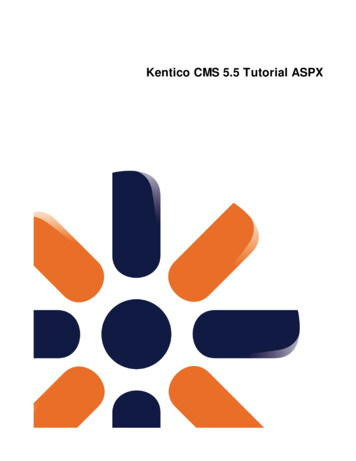
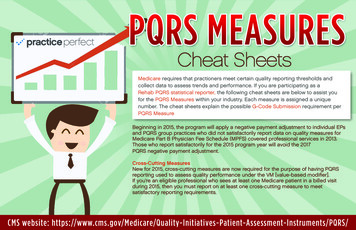
![Unreal Engine 4 Tutorial Blueprint Tutorial [1] Basic .](/img/5/ue4-blueprints-tutorial-2018.jpg)
